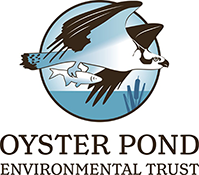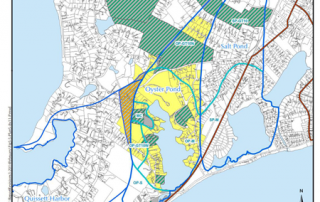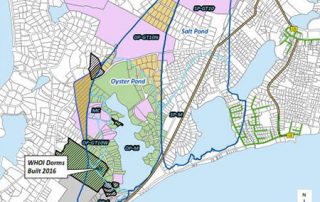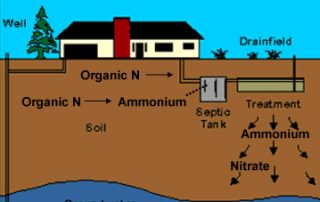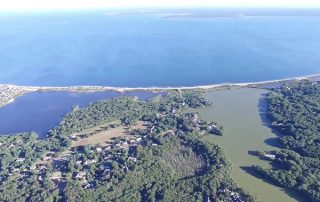Science
A Plan to Clean up Oyster Pond
There is too much nitrogen in Oyster Pond. The high levels are mainly from too many conventional septic systems in the watershed. The 2016 summer algal bloom that turned the pond green was due in part to the high level of nutrients.
Nearly 70% of the nitrogen entering the pond must be removed. Septic systems are the main source, although garden fertilizers and storm runoff also play a role. Title V septics are great at removing pathogens from entering groundwater, but not nitrogen. Just as nitrogen feeds your garden plants, it also feeds the plants or algae in the pond. Removing this pollution source will be the key to restoring Oyster Pond to a healthier ecosystem.
A Comprehensive Wastewater Management Plan for Oyster Pond
The Town of Falmouth is developing a Comprehensive Wastewater Management Plan (CWMP) for Oyster Pond to return it to a healthier ecosystem by limiting the amount of nitrogen entering the pond. Oyster Pond is one of fifteen estuaries in Falmouth degraded due to too much nitrogen in the pond water. The Town of Falmouth is mandated to reduce this nitrogen entering the estuaries by the Clean Water Act of 1973. It is working with consultants to develop Comprehensive Wastewater Management Plans for each of these impacted water bodies. The Town appointed Water Quality Management Committee (WQMC) is the volunteer committee investigating and pursuing solutions for these water bodies.
A CWMP considers all wastewater treatment alternatives and prepares a cost effective analysis of treatment options. What is the most economical and efficient method for cleaning up Falmouth’s estuaries? How much will it cost? Who will it impact? These are the questions explored in CWMPs. The WQMC is exploring using everything from eco-toilets to sewers to inlet widening as treatment options, while tailoring them to fit the unique needs of each waterbody. The level of treatment is based on how much nitrogen must be removed to return the water back to good water quality. This is known as the Total Maximum Daily Load (TMDL) or the maximum amount of nitrogen that can enter a pond and not degrade its water quality.
The TMDL for Oyster Pond was based on results from the Oyster Pond Massachusetts Estuary Project (MEP) report. The MEP set a TMDL for both the concentration or amount of nitrogen in the water column (expressed as mg/l) and the load or amounts entering ponds (expressed as kg/day or kg/year). After the TMDLs are set, the results are sent to the Massachusetts Department of Environmental Protection (DEP) and the Environmental Protection Agency (EPA) for their approval. Once the TMDLs are accepted by those authorities, the Town of Falmouth is obligated to meet the TMDLs. Oyster Pond’s TMDLs were accepted by the EPA in 2008.
The Oyster Pond CWMP includes the following:
- Needs Assessment – gathered physical, biological and water quality information to evaluate the pond’s current condition
- Develop and Screen Alternatives – due diligence of exploring all treatment alternatives, even though most of them are not feasible for Oyster Pond (e.g., eco-toilets)
- Evaluate Alternatives – five potential treatment options were explored
- Identify Recommended Plan – two main scenarios selected as feasible for Oyster Pond – (Plan 1) installing sewer lines in a portion of the watershed or (plan 5) requiring nearly all the homes in the watershed to upgrade their septic system to an Advanced Innovative & Alternative (I/A) denitrifying septic
Town Selects Two Treatment Options – Advanced Innovative Alternative Septics or Sewers
Currently, the Town has elected to proceed with Advanced I/A septic systems (previously known as Plan 5) as the Preferred Plan, while sewers (Plan 1) will be the Traditional Backup Plan. The Advanced I/A plan requires up to 233 dwelling units to upgrade to an Advanced Innovative/Alternative septic system if needed. Advanced I/As emit much less nitrogen than even regular I/As. Plan 1 requires 189 dwelling units around the pond to connect to low-pressure collection sewers. In 2024, the Town will reevaluate both plans and make a final determination as to the best plan to implement. More information about the different types of septic systems and sewers can be found here.
There are still many unanswered questions and uncertainties that must be addressed in both plans. The WQMC will spend the next few years investigating these issues.
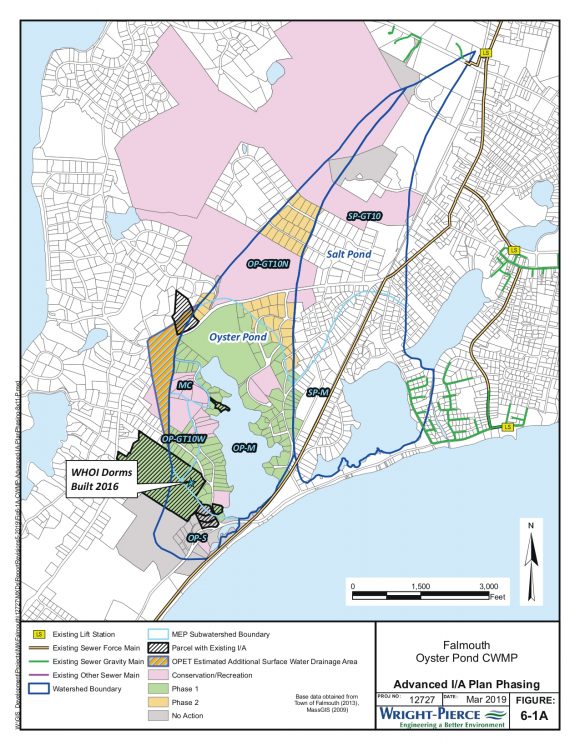
Proposed Plan for Advanced Innovative and Alternative Septic Systems Map – A total of 189 dwelling units would be required to upgrade to an advanced denitrifying septic system in Phase 1 (green shading). If Phase 1 does not remove enough nitrogen to meet the goals of the plan, then in Phase 2 (yellow parcels) the remaining 44 homes will be required to upgrade their septic system.
If implemented, the Advanced Innovative/Alternative Plan will be conducted in two phases. Phase 1 will require the 189 homes closest to the pond to upgrade their septic system. The Town will continue to monitor and assess the effectiveness of Phase 1 for improving the condition of the pond. If Phase 1 is working, but additional nitrogen must be removed, then Phase 2 will move forward and require the remaining 44 homes to also upgrade to Advanced I/As. It is estimated Phase 2 will not occur until the year 2040.
Once a start date is set for implementing Phase 1 of the Advanced I/A plan, homeowners have one year to obtain a permit to install the new system and three years to complete the work. They must also grant the right for the Town or a designee to access their property to periodically inspect and test the septic system. The costs for implementing the plan will be split between the Town and the homeowner. The Town will supply the physical components of the Advanced I/A system while the property owner will be responsible for the site engineering plans, permitting costs, Title 5 system components plus installation and landscaping expenses. Additionally, they must pay a semi-annual fee for the costs of testing and monitoring their systems. Advanced I/A costs range from $4,030 to $5,080 per year depending on the frequency of inspections of the system that might be needed.
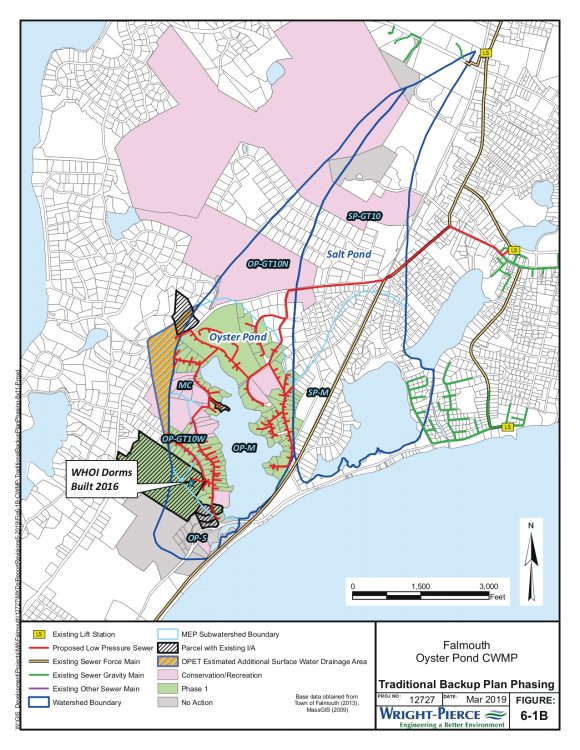
Proposed Sewer Map Plan for Oyster Pond – parcels in yellow would be connected to the sewer system. A total of 189 dwelling units would be connected.
If the sewering Traditional Backup Plan is selected 189 dwelling units will be connected to a low-pressure sewer system. This type of sewering system will require a low-pressure lift station at each residence. The effluent will be sent to the Blacksmith Shop Road Wastewater treatment facility. The cost for the sewering plan per household is estimated to be $4,080 annually.
Even though the draft CWMP is complete, it will still be years before any of these plans are put in place. There are still many unanswered questions. Section 6.9 Next Steps reviews the technical questions and additional data that must be gathered. There are political considerations, too. Will the MA Department of Environmental Protection allow a CWMP based only on the use of I/As to meet the needed nitrogen removal goal to restore the pond? It’s never been done before. I/As need a lot of monitoring to ensure they are functioning properly. What type of protocol needs to be put in place to make sure homeowners are complying with their septic system monitoring? Another question is how to equitably pay for I/As if they are required. Falmouth has paid for 30% of the sewering costs for the Little Pond neighborhood. How will they do that for I/As? Buy the systems in bulk from a vendor?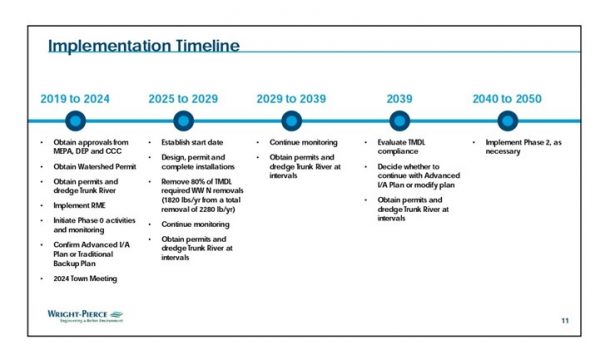
Oyster Pond CWMP Implementation Timeline from a powerpoint presentation by Wright-Pierce, the Town’s consultant.
How Did We Get Here?
The road to devloping a Comprehensive Wastewater Managment Plan for Oyster Pond
…. It was over 25 years in the making
In the mid 1980’s alert Falmouth residents noticed a profound change in our estuaries.
* Mid 80s – Pond Watchers Citizen Monitoring program initiated for Oyster, Litte and Green Ponds.
*1987 – Town Meeting appropriated $5,000 “to conduct investigations of the physical, chemical, and biological characteristics” of Oyster, Little, and Green Ponds and to prepare a “comprehensive program for restoration, preservation and maintenance”.
* 1989 – Collapsed culvert at Surf Drive replaced with larger one increasing salinity and causing profound changes to the pond
* 1998 – Weir built to control pond salinity
*2005 – Massachusetts Estuaries Project (MEP) report setting Total Maximum Daily Load (TMDL) for bacteria for Oyster Pond.
* 2006 – Listed as an impaired water body due to nutrients & pathogens on Mass Clean Water Act 303 (d) list
* 2007 – Final MEP report setting TMDL limits for nitrogen for Oyster Pond.
* 2008 Total Maximum Daily Loads (TMDLs) for nitrogen approved for Oyster Pond by the EPA and DEP.
* Aug 2010 – Buzzards Bay Coalition & Conservation Law Foundation file suit against EPA for “failing to properly manage sources of nitrogen pollution like septic systems, stormwater, & wastewater treatment plant discharges on Cape Cod including Falmouth and Bourne.”
*Spring 2011 – Falmouth passes a $2.7 million funding package for wastewater treatments and studies that includes $300, 000 for an Oyster Pond CWMP.
* Nov 2012- Town issues an RFP for Oyster Pond CWMP. Wright-Pierce selected.
*Sept 2019 – Draft Oyster Pond Comprehensive Wastewater Management Plan (CWMP) released.

